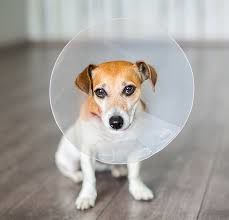What are the Benefits of Desexing Female Dogs
The most obvious advantage is that the female dog will not get pregnant, however, there are a lot of other benefits. It is often messy having a female dog bleeding whilst living inside our house. A bitch on heat will attract a posse of male suitors who can camp on your doorstep, waiting for a chance to woo her.
The same hormone surges that ready her uterus and mammary tissue for potential pregnancy and lactation, can have long term damaging effects on those same tissues, especially if the bitch does not fall pregnant. This seems somewhat counter-intuitive, but pregnancy is actually protective of uterine infections, and suckling puppies has a protective effect against breast cancer.
The rate of womb infections in later age in unmated, undesexed dogs is really quite high. This is called a "pyometra" and is a potentially fatal emergency. Similarly, mammary cancer in unmated, undesexed dogs is a significant risk. We know that breast cancer is unknown in dogs that are desexed before they ever have a heat. This is a huge preventative health benefit.
Ovarian cancer also occurs in undesexed dogs, but as we remove the ovaries when we desex a bitch, they cannot get ovarian cancer. The sex hormones can also have effects on organs unrelated to reproduction. It is well documented that oestrogen can predispose a dog to developing diabetes mellitus (sugar diabetes).
In summary, a desexed female will not come on heat, fall pregnant, develop mammary or ovarian cancer or get infections in the uterus.
What are the advantages of desexing male dogs
Male dogs will never get pregnant which is why so many dog owners think there is little need to desex them.
However, those pesky sex hormones do cause complications, especially in an urban environment.
If your male dog is attracted to a female on heat, many kilometres away, he will want to get out. He may try to escape from your yard, destroying fences etc. in the process, and if he gets out, will probably cross the road, with love on his mind rather than road sense. The risk of him being hit by a car is significant.
Even if he cannot escape, the frustration of not being able to get out and mate the bitch can have consequences.
The unrequited love can stimulate his prostate leading to overgrowth or "Hypertrophy". This is normally benign, although cancers can occur in the prostate of the male dog. It does seem that prostatic hypertrophy is more common in the sexually inactive male dog than in stud dogs. One nickname for the condition in humans is the "monk's disease" - it is not Casanova that has prostate problems!
Cancer of the testicles is also a problem that we see in dogs. The cancer can be dangerous and potentially spread to other parts of the body. Other testicular cancers can produce higher than normal amounts of hormones; sometimes male hormones, but also female ones, all of which can have profound effects on temperament, skin, muscles and other remote parts of the body.
Testosterone can also have unwanted effects in making dogs more aggressive and at higher risk of harming other dogs or being involved in fights, and less inclined to listen to their owners.
If a male dog is desexed before it starts to lift or "cock" its leg to urinate, it will not do so afterwards. Once it cocks its leg, it will usually continue to do so. This can ruin a good walk, when a male dog - desexed or otherwise - wants to urinate and leave its mark on every telegraph pole and letter box along the way.
So, in summary, desexed male dogs will be easier to keep home, more loyal, less prone to prostate problems, and less likely to be involved in fights.
What are the cons of desexing a female dog
The only real reason not to desex a female dog is that she will be unable to have puppies. A common fallacy is that desexed dogs get fat and lazy. This myth is explained away by the lower energy requirements of a desexed dog. Quite simply a desexed dog makes more efficient use of its food as it is not diverting that food into making hormones. Nor is she gearing up and dismantling the uterus and mammary tissue and all the other heat related activities.
So if you continue to feed the same amount of food as you did prior to the operation, she will store away the extra as fat. The same applies to every animal as it matures; its daily energy requirements drop and, unless you reduce its energy intake, it will get fat.
What are the disadvantages of desexing a male dog
Again, male dogs cannot breed if they are desexed. Dogs do not have sex for "recreation" so they will not be "missing out" if they are desexed. The lower testosterone levels in a desexed male dog will limit the amount of muscle mass. This is most evident in dogs that are desexed at a very young age - especially prior to six months of age.
What is involved in desexing a dog?
There are two ways to desex a dog - the most common way is surgical desexing. When a dog is desexed it requires a full anaesthetic. We remove the entire reproductive organs from female dogs - that is the uterus (womb), the Fallopian tubes ("the tubes") and the ovaries. It is technically possible to "tie off the tubes" in a dog as is done in women for birth control. However this, while an effective way to stop the bitch from conceiving, would leave behind the ovaries so she would still come into heat and have all the risks of mammary cancer. It would also leave behind the uterus with the attendant risks of pyometra.
We remove the entire reproductive organs through a small, incision in the midline of the abdomen. Laparoscopic surgery can also be used, but always requires at least three abdominal incisions and in most cases results in larger incisions than the single incision that an experienced surgeon requires for conventional surgery.
Male dog desexing is a simpler procedure. It is essentially a skin incision and most male dogs trot out of the hospital later that day as if nothing had happened!
What is the best age to desex a dog?
If the only aim of desexing was to prevent reproduction, it could be done at any age. However, as we have discussed above, there are many other benefits to preventing hormone damage and changes within the body, by desexing a dog before it hits maturity.
For this reason, it is best to desex a dog at about six months of age. Some vets will desex dogs earlier, but there are no documented benefits in doing so, and in most cases it is far better to allow the liver and other organs that process anaesthetics to mature. This will all have occurred by the time a dog reaches six months of age.
In Summary
Desexing dogs that are not going to breed will give them the greatest chance of living a long and healthy life. They will not be distracted by the whole breeding cycle, will be better pets and will integrate more easily into our households. The best age to desex them is at six months. A quick day in hospital will give a lifetime of benefits
Always consult your vet regarding the best time to desex your pup as breed and size will have an impact on timing.
Dr. Gordon Heslop, 2016
Bachelor of Veterinary Medicine. Member of the Royal College of Veterinary Surgeons. B.Vet. Med., M.R.C.V.S.


